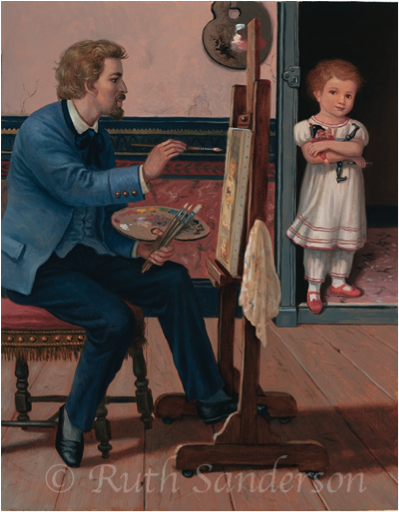
A Storm of Horses: Behind the Scenes
When I was in art school in the 1970’s, I stood awestruck in front of a gigantic painting of horses at the Metropolitan Museum of Art in New York City. The Horse Fair (Le Marché aux Chevaux in original French) by Rosa Bonheur impressed me with its masterful realism and its narrative quality, depicting animated horses, handlers, and riders in a complex scene of action and interaction. It remains my favorite horse painting to this day.

Here is a picture of me standing in front of the painting in 2018, when I first started my biography of Rosa Bonheur, a remarkable woman artist who was born in 1822, two hundred years before the publication in 2022 of my picture book story about her life.

In contemplating writing and illustrating a biography of Rosa, I came across an unfinished painting of horses on the Internet that was on display at the Château de Rosa Bonheur. This picture gave me the idea to possibly create a story that focused on her process of creating The Horse Fair, since I could directly see the way she handled the stages of a painting of horses. This was something that interested me greatly as an artist, and something I hoped would interest young readers. My primary source of the details in this story was the (auto)biography she dictated to her artist friend, Anna Klumpke, along with Stanton’s Reminiscences, both of which have many direct quotes by the artist. In those books I was thrilled to learn many details about her life, as well as her process, her colors, and her methods of working.
Artists all have different methods of working, and Rosa didn’t seem to always follow the exact steps she mentions in her autobiography. She states that after she drew the outlines on her canvas with “burnt red ochre,” she rubbed the background canvas with a neutral gray, but I saw no evidence of this on the unfinished horse painting when I viewed it in person, so I did not include it in this story. I use a few different methods myself for oil paintings and cannot be 100% sure on this detail. Her partly finished painting in my illustrations is what I imagine it might have looked like at various stages. I could not find a mention of her method for transferring her drawing onto the canvas, but imagine she used the traditional grid method used by most academically trained artists in those times. A simple exercise for students on the grid method is included in the Teacher’s Guide for the book, created by Marcie Colleen. The guide is available as a free download, here.

Edmund Texier’s Tableau de Paris is a huge collection of engravings of Paris scenes published in 1849, and it includes some artists’ studios, one being Rosa’s, with stalls for her horse and other animals at one end. (My dream studio!) This was the studio she rented right before she started work on The Horse Fair, and I was excited to find such a perfect piece of picture reference for my illustration of that scene. I inserted my picture of my model for Rosa into the engraving, to help me with the proportions of the scene, and I also used some of the photos I took of items in Rosa’s home in Thomery, which is now a museum.


Here is my sketch and the finished illustration for the scene.

Another page in the Tableau depicted the Anatomy Hall at the Garden of Plants. I used that, along with pictures I took there myself in 2019, and photos of my model for Rosa of course, for the scene where she is drawing the horse skeletons. The hall looks a bit different now, but I imagine they are the same skeletons that have been there for 200+ years.


As I mentioned, I had the good fortune to visit Rosa’s preserved studio in Thomery, France, at the Château de Rosa Bonheur in 2019. I took lots of useful reference pictures of studio furniture, her paint and palette, her smock and other clothing, taxidermy animals, plaster casts, animal sculptures, and even her saddle. Her father’s painting of Rosa at four years old holding a pencil was the inspiration for the first illustration and the beginning of my story.

Rosa describes her goal for another large horse painting, Threshing Wheat, and this quote might easily apply to The Horse Fair as well: “It is my dream to show horses snorting fire and dust welling up around their hooves. I want this infernal waltz, this wild tornado to make people’s head’s spin.” With The Horse Fair, Rosa certainly realized this dream. My illustration and the title of the book, A Storm of Horses, were inspired by this quote.
My dream for this book was to shine a light on Rosa’s accomplishment by depicting what her process was like when she was creating a magnificent painting six feet high by eighteen and a half feet wide called The Horse Fair this, and how much time and work went into it. This book is my homage to Rosa and an expression of our shared love of horses.


